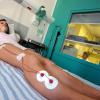This month: Nanoencapsulation

What is nanoencapsulation?
It is a technique based on enclosing a bioactive compound in liquid, solid or gaseous states within a matrix or inert material for preserving the coated substance.
Are there new developments?
Yes, Brazilian scientists have published a study in which they combined substances extracted from fruit residues and egg white to package nanoparticles of anthocyanin – a plant pigment with antioxidant action.
Tell more me.
Many studies are looking for ways to optimise absorption of bioactive compounds by the organism and increase their bioavailability – the proportion that enters the bloodstream after absorption.
One way is to coat the compounds with another material and package them on the nanometric scale – nanoencapsulation.
What does this technique do?
It assures slow release of the compounds so that they take longer to digest and can survive the attacks of bacteria in the gut microbiome.
How did they coat the compounds?
They used pectin extracted from residues of citrus fruit and peel and albedo (the white spongy material inside the peel of oranges and lemons), permitting human ingestion and excluding any kind of hazardous chemical.
What are the advantages?
According to the researchers, the main advantage of their methodology is that no compounds are added apart from pectin, lysozyme and anthocyanin, so there are no salts, ligands or anything potentially toxic. Also, the nanoparticles are not too small – very tiny nanoparticles can penetrate barriers and cell membranes, entering the DNA and having toxic effects.
What were the results?
They tested the methods in vitro and found partial and gradual release suggests absorption of the compound starts before it enters the gut, with the nanoencapsulated remainder probably being released in the gut or fully absorbed with less structural alteration.
What will they do now?
The next stage is to test it in animals, observing the process of oral ingestion, absorption of the anthocyanin using specific markers for absorption, and the route followed in the organism.
Where can I read more?
You can read the full paper by visiting bit.ly/40sRbli
Image credit | iStock



